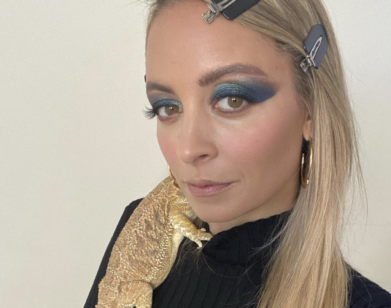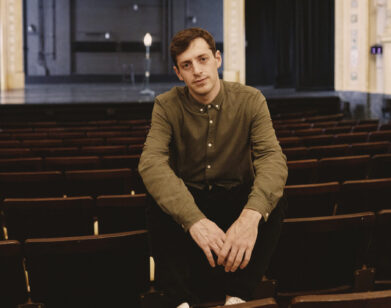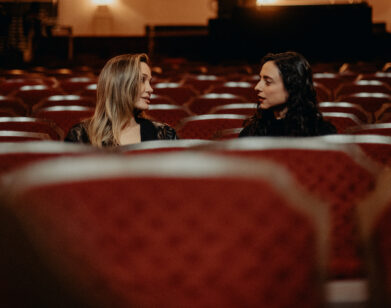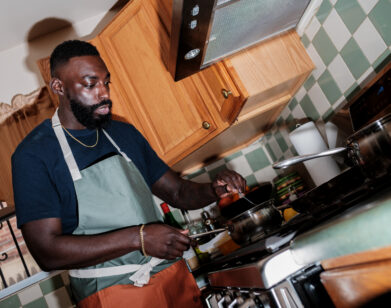Molly Prentiss’s Technicolor Debut
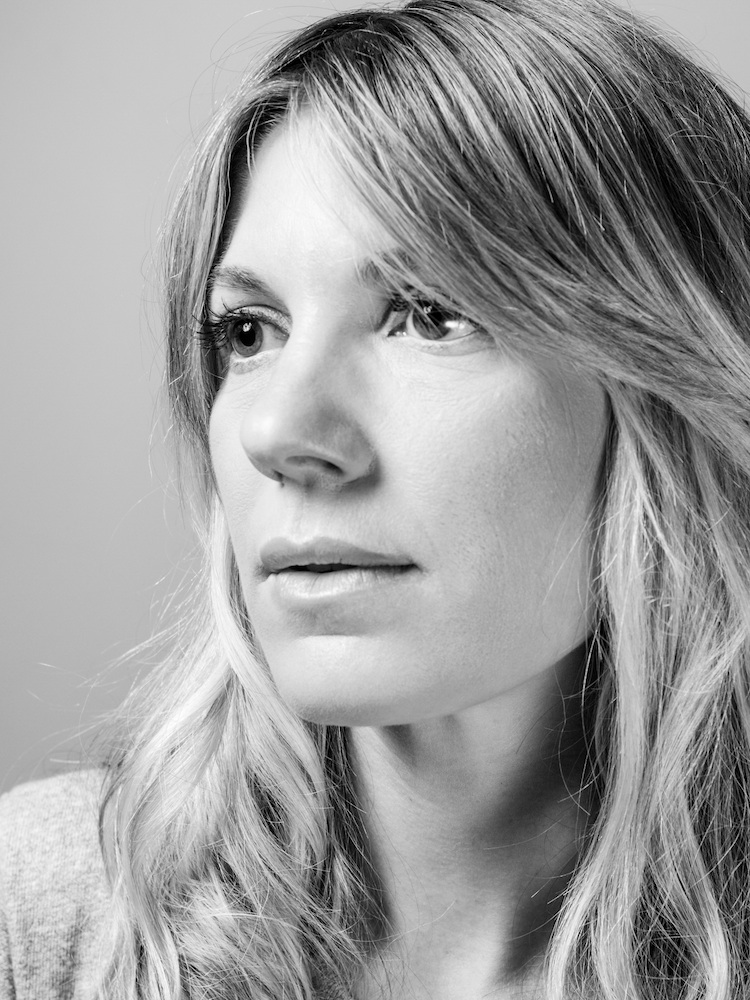
ABOVE: MOLLY PRENTISS IN NEW YORK, MARCH 2016. PHOTO: MARK DAVIS. HAIR AND MAKEUP: MAHFUD IBRAHIM/EXCLUSIVE ARTISTS MANAGEMENT USING ARMANI BEAUTY.
Vivid and ambitious, Molly Prentiss’s debut novel Tuesday Nights in 1980 (Scout Press) is a multi-sensory experience. Set, as the title suggests, in 1980, it is anchored at one end by the New York art scene—from blue chip dealers to a budding Basquiat—and at the other by the political repression stifling Argentina. Through her three protagonists, Prentiss presents different shades of New York. There is James, a socially inept art critic who ascribes everything a color (confidence, for example, is orange, while new money is purple, and his wife is a strawberry red). Argentine immigrant Raoul is a confident, talented painter. Then there is Lucy, a 22-year-old from the Midwest who feeds of creativity and longs for a larger life. Each character faces his or her own tragedy at the hands of the city, and Prentiss’s omniscient narration weights the novel with dread.
Raised in Santa Cruz, California, and now based in New York, Prentiss received her MFA in creative writing from the California College of the Arts. She has been working on Tuesday Nights, which comes out today, since graduate school.
EMMA BROWN: Were you ever part of the art world?
MOLLY PRENTISS: I’ve never formally been in the art world. I went to graduate school at an art school so I was around a lot of visual artists. I met my boyfriend there and he’s a visual artist. All my best friends at school were artists. They really informed a lot of what I was thinking about when I started the book. I come from a family of artists; my dad’s a painter, my mom is a radio producer, and my grandfather was a painter too. I definitely have that in my background, but I’ve never studied art or art history. It’s just an interest.
BROWN: The 1980 art scene in New York is quite specific, how did you come to that?
PRENTISS: I’m sort of a whim follower. I guess every artist or writer is; that’s the nature of creative work. One of my favorite things to do is to create new characters based around characters I’ve already created—someone’s brother, someone’s uncle. I think the most fun thing to do in writing fiction is making a new character out of thin air and then figuring them out and following them to the next character, following their life and their past. I landed on 1980 by doing something like that. It used to be set in present and then I was writing about that person’s uncle and they were around in the ’70s and ’80s. As I was sussing him out, he ended up becoming one of the main characters in the book, Raul. It was like a bell ringing; I was interested in all the things surrounding him.
BROWN: So Julian was your initial protagonist?
PRENTISS: A really long time ago, probably eight years ago, I wrote a short story about a teenager named Julian. He came to New York and originally he had fallen in love with a young barista. Then I shifted that story onto Raul and Lucy, and she became a bartender instead of a barista. I do a lot of shifting of stories onto new characters, depending on which characters feel the most exciting to me. I landed in 1980 and started becoming obsessed with it. There just was so much energy there, even when you look at pictures or read about that time. I did a lot of research on the art of that time, and it all felt really exciting and electric to me. But it was a whim that got me there. I didn’t set out to write a book about the ’80s. I wasn’t even alive in the year my book takes place, but there is a sort of romance that surrounds the idea of it.
BROWN: I also wanted to ask synesthesia, which James has in the book. Is that something you’ve experienced personally? How did you find out about it?
PRENTISS: No, I don’t have it. The other night I was having dinner with a friend and we got into this argument about what color each day of the week is. He and I both had really strong feelings about which color represented which day of the week. I was like “Monday is red,” and he was like, “No, Monday is brown.” We had this whole conversation and neither of us has synesthesia, but I do think everyone has strong associations. It was really fun to write about because I got to use my own associations as James’s. In terms of how did I fount out about it, I met a woman in grad school who had it. She walked up to me and said, “You’re peach.” She described it and I had never heard of it before at that point. I forgot about it. When I was writing the book, James had gone blind in an original draft of the story, and I ended up remembering and rethinking about synesthesia. I did a bunch of research about it—there are a lot of chat rooms where people talk about their experiences of synesthesia, which are endlessly interesting to me. In one of them a woman talked about losing her synesthesia after having a traumatic life event. It’s a part of you and a part of your creative identity, what would it be like to lose that? I think that’s a question the whole book asks: What happens when the things that make you up and define you and are taken away from you? How do you move on? What becomes the center of your life? I really wanted to follow those trajectories in these three ways with these three main characters.
BROWN: Do you often find yourself having orphan characters?
PRENTISS: Definitely. I’ve scrapped so many characters. I’m really ruthless about getting rid of things. At one point my agent had me cut 200 pages. I cried in the elevator on the way down from the office, but then I was like, “I’m doing it.” I just sliced the book in half and deleted it. I think I’m a newness person. I like starting new. It doesn’t actually scare me that much to get rid of stuff. I think all the work you do finds its way back into the final thing if it’s important enough.
BROWN: People often talk about how smell being the strongest memory trigger. Do you find you’re more of a visual person?
PRENTISS: Yes. I think the visual realm affects me a lot. I can become easily depressed by something if it’s visually unsettling and I love arranging things in ways I find pleasing. My dad also picks colors for people’s houses. I remember as a kid, I was kind of embarrassed by it because he’d always pick these really wacky colors. He picked the colors for this elementary school in my hometown and it was pretty outrageous. I remember these girls on my soccer team being like, “That school is so ugly.” I was really embarrassed, but later I thought it was brilliant. It was so wacky and genius. I do think a lot in color, and I think a lot about color. Sometimes it can be hard writing in little black and white words and trying to make the color out of these words.
BROWN: Did you ever consider having pictures of the art that you reference in the book?
PRENTISS: At one point, I had each of the chapters open with a piece of art or an image. In the end it felt forced, so my agent and I decided against it. I really do believe that time and patience and crazy work are necessary to make something you’re really proud of, and I don’t think I’ve done that with visual art. I have never studied it in the way I’ve studied writing, and I’ve never put the time into learning about it that I have with writing. Maybe that’s just my crazy work ethic talking, but I think if you’re going to put art in the book it has to be right. I wasn’t there yet with that part of it.
BROWN: In the book there’s a lot of portent, sentences like, “There was no way to know then that it would be the last celebrating they did for a very long time.” Was that something you did consciously or did it just come out that way?
PRENTISS: It was conscious. Anything that happens in this book that is plot oriented or driving the narrative is something I really had to be conscious about because it’s not my natural tendency. My natural tendency is for creating a mood and description and developing characters and going off into a lot of directions. I had to work really hard; the past four years were spent tightening and driving the book. There are countless ways to do that that you learn in school, or you can read a book called, like, How to Write a Novel. I seriously did stuff like that, I was five years into writing this book and I was like, “I need to learn how to write a book.” It took so long to get to the point where it worked and gelled and could push forward. I can’t imagine just spitting out a story and having it work.
BROWN: When you’re working on something for so long, how do you maintain your interest in it? Was that an issue for you at all?
PRENTISS: Yeah. There were times when I was so over it. I think a lot of writing is about tricking yourself. Pretty much every day when I sit down to write, I have to trick myself into doing it. I’ll read something and find a sentence that feels exciting and trick myself into thinking that makes me want to write something down. I would find new angles of looking at it—trying a new style of writing really gets me going. That’s where the portraits that exist throughout the book come from, I thought, “What if I could do these little prose poems that energize the text and make it feel different from the rest?” Coming up with those conceits or writing from a new character’s voice always gets me back into it.
BROWN: Were there certain characters you found consistently easier to write for, or was it more about who was the most exciting and fresh?
PRENTISS: Lucy was always really easy to write, for me. Raul, too, came naturally because I felt like I knew who he was from the get go. James was super tricky. He was the thorn in my side through the whole process of the book. My agent kept saying “I don’t know about James, who is James? What does he want? What is he doing here?” I really thought about him the most and worked on him the most and tried to get at who he was and the core of him. In the beginning, I didn’t really like him and I think that was the problem. I was thinking of him like a schmuck. At the end, I felt I had a tenderness for him. That’s important when you’re writing characters because I think the reader needs to find some way to be interested or at least feel a softness for a character. Even if you hate them, even if they fuck up all the time, you still need to be able to find some kind of humanity.
BROWN: With characters you instantly have that connection with, do you feel bad when bad things happen to them?
PRENTISS: Yeah, totally. You want to solve their problems. You want to figure out, “Okay, this bad thing happened to them, how can I get them to see they still have an existence and there’s still beauty in the world?” That was one of the big missions of the book, for me. How do you continue to find beauty in the world after your worst nightmare happens?
I remember one time when I was having a really hard time figuring out the plot of this book. My mom is really great at figuring out story arcs because that’s what she does for a living with her radio pieces, and she said this thing: “Sometimes you just have to have your characters really fuck up. Sometimes you’ve got to have them do the thing that’s the worst.”
BROWN: Maybe I’m projecting because obviously bad things happen to the men in the story, but I felt so much sadder for the women. Marge and Lucy never quite reach their full potential. Was that something you thought about?
PRENTISS: Yeah. I think especially as a young woman in New York like Lucy is—even for me when I first move to New York when I was 22, which is how old she is—there is a feeling like you’re not allowed to be somebody yet. It’s hard to describe, but I wanted to contrast that with Raul’s, “I want to be this badass painter, I’m going to be famous.” There’s this thing I see constantly with young women where you’re afraid to even call yourself anything. I don’t think I would have called myself a writer until my book was done and sold. That’s something that isn’t blatant in the book, but it was an experience that I wanted to illuminate—that feeling of being a young woman in New York, not quite knowing how you can be what you want to be.
It’s the same thing too with Marge. I see this constantly with women I know who are in their 20s and 30s who are in partnerships—it’s the women who are like, “We need to get our shit together so I’m going to get a job.” Marge forgave her creative career to get an advertising job. It’s that practical side of women. Marge couldn’t be like, “I’m going to be a famous artist,” she was like, “I need to figure out how to live in New York and be stable.”
BROWN: Argentine politics serve as a backdrop to the book. How did that come about? It’s quite a huge undertaking.
PRENTISS: At the time I was starting my book in my second year of grad school, I took this course with Claudia Bernardi. She is from Argentina and her work is about disappeared populations around the world, focusing on Argentina. She studies and works with the art that comes out of those political catastrophes. Her class was so interesting and so moving. During the class—it was a group of visual artists and writers—we were each turning in creative projects that had to do with all of these things we were reading about. I ended up creating [Raul’s sister] Franca, who’s actually based on a young woman who was 18 and captured and killed in Buenos Aires. I read a factual piece about the actual Franca and created fake Franca in that class. I was doing that while I was working on my book about artists in the ’80s, and I realized that these things were happening at the same time, and how wild that in one country that’s not so very far away people were being totally repressed and being captured for being “radical.” Tons of these people were artists and writers, intellectuals. Meanwhile up north the opposite thing is happening where it’s about prizing personal expression rather than suffocating it. That juxtaposition was interesting to me. I had originally written much more about Franka and much more about Argentina, half the book took place in Argentina at one point. After reviewing where the heart of the book was when I was doing all that tightening and narrative work, it could never make sense. [But] it was important to me that it remained this undercurrent weighted at the bottom of the book.
BROWN: When you’re writing, do you ever worry about reading fiction, that it will seep into your prose?
PRENTISS: No, I’m not of the camp that worries about other people’s voices interfering. I definitely can be influenced, but I like to use that. When I like a book, I pray to be influenced by it. You’re never going to sound like that person and no one would ever put it together that you’re mimicking [them]. Maybe you see all the ways that you’re mimicking someone, but I think it always ends up sounding like you in the end. I happen to like when I get little influences from other writers, and I use that as a generative feeling. It can happen from anything. Often reading things that are completely nonfiction—reading articles or the newspaper or theory—can be almost more generative than reading fiction. Sometimes reading fiction I get so involved with the loveliness of reading that I forget to have ideas. Sometimes it takes a more practical or denser text to actually have part of my mind thinking in an idea way. What fiction does do is I get so obsessed with certain sentences and the way certain words sound together. When I read a beautiful sentence or a beautiful paragraph, it really makes me want to write. When writing feels really musical, that always inspires me.
TUESDAY NIGHTS IN 1980 IS OUT TODAY, APRIL 5.

